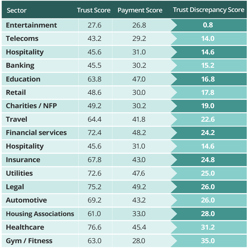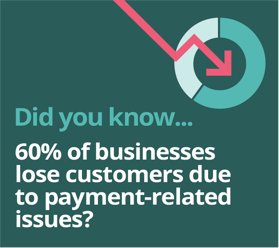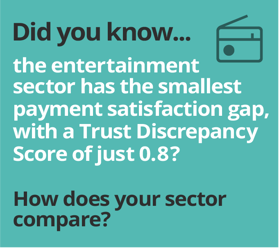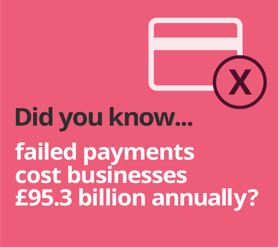
Customers now demand not only security and reliability but also speed, convenience, and personalisation in their transactions. This heightened focus has created both challenges and opportunities for businesses across sectors.
As industries navigate this complex terrain, it becomes clear that payment experiences are no longer a mere operational detail - they are a critical component of the overall customer journey. Sectors that can align their payment systems with broader customer expectations will not only retain loyalty but also gain a competitive edge.
Conversely, those that lag in adapting to modern payment preferences risk losing market share. By examining the data, we can identify which sectors are leading the charge and where substantial gaps that threaten customer satisfaction and loyalty exist.
The guide will cover
- Which sectors are leading the way?
- Which industries are struggling?
- How can financial services improve payment experiences?
- What happens when payment experiences are poor?
- What are the key insights for businesses?
- Payment Experience Index methodology
Looking at 160 businesses across 16 sectors, our Payment Experience Index demonstrates which industries are performing best when it comes to offering payments experiences to their customers.
We analysed average TrustPilot reviews and gave each business a score out of 100, before doing the same for reviews where 'payment' was a keyword. We then calculated the difference between these to work out a Trust Discrepancy Score for each sector, to highlight which industries are offering their customers seamless payment experiences, and which are struggling.

Which sectors are leading the way?
Access PaySuite’s analysis found that the entertainment sector leads the pack with the smallest gap in customer satisfaction between overall experience and payment processes, showing a minimal Trust Discrepancy Score of 0.8.
This consistency underscores the sector’s ability to integrate seamless payment solutions into its offerings. Membership-based services, such as streaming platforms, benefit greatly from robust subscription payment processing and management software, enabling hassle-free transactions that keep customers engaged.
Businesses in the entertainment sector can further capitalise on their success by optimising recurring billing systems and ensuring smooth subscription renewals to maintain their competitive edge.

Which industries are struggling?
At the opposite end of the spectrum, the healthcare sector demonstrates one of the largest Trust Discrepancy Score of 31.2, signaling a pressing need to improve payment experiences. For a field that is inherently service-oriented and often emotionally charged, a streamlined and intuitive payment process can alleviate stress and enhance patient satisfaction.
Insights from our recent survey highlight the growing demand for flexible payment options, digital invoicing, and transparent billing systems within the industry. By addressing these needs, healthcare providers can close the satisfaction gap and build trust with their patients.
Meanwhile, the gym and fitness industry faces the most substantial challenge, with a Trust Discrepancy Score of 35 between overall customer satisfaction and payment experience. This indicates a significant disconnect that could impact member retention and growth.
Gyms and studios must prioritise user-friendly payment solutions, such as mobile apps for membership management and secure online portals for class bookings and subscriptions. Our recent report found that fitness businesses must explore innovative payment methods like flexible payment plans and contactless options to improve the customer experience.

What challenges do service-oriented and essential sectors face?
According to our findings, service-oriented sectors, including healthcare, automotive, and legal services, often show larger Trust Discrepancy Scores than other sectors. These discrepancies suggest that while customers may value the core services provided, outdated or inconvenient payment processes detract from their overall experience.
To address this, businesses operating in these industries should focus on integrating multi-channel payments solutions that offer flexibility, security, and ease of use to their customers. Automated billing and real-time payment tracking options are just a few ways to bridge the gap.
Meanwhile, essential services, including utilities and housing associations, also reveal significant Trust Discrepancy Scores. Given the necessity of these services, improving payment processes is not just a convenience, but a critical component of customer experience.
Offering options like Direct Debit, online payment portals, and proactive communication about billing cycles can enhance customer satisfaction and reduce friction.
How can financial services improve payment experiences?
Surprisingly, financial services - encompassing banking, insurance, and other money-handling sectors - showed notable gaps in payment satisfaction in our research. Despite their expertise in managing finances, these industries have room to refine their payment processes.
According to surveys we have conducted across these sectors, including our latest Insurance-focused report, and our analysis of payment trends in the financial sector, customers increasingly prefer using digital wallets, mobile payments, and personalised billing experiences.
By embracing these preferences and investing in user-centric technology, financial services can turn this challenge into an opportunity to strengthen their market position.

In 2025, the sectors leading in payment experiences will be those that prioritise seamless, secure, and customer-centric solutions. Our Payment Experience Index demonstrates that businesses embracing innovation in payment technologies are not only meeting customer expectations but redefining them. This is about more than just enabling transactions - it’s about creating a smooth, transparent, and reliable experience that builds trust and fosters loyalty
What happens when payment experiences are poor?
Payment performance plays a pivotal role in shaping brand image and influencing customer behaviour, from conversion rates to retention.
According to UK Government data, the average cart abandonment rate stands at 30%, with some studies reporting figures as high as 70% to 80%. Key reasons for abandonment include hidden costs, concerns about payment security, and a lack of preferred payment options.
Globally, failed payments result in a staggering £95.3 billion annual loss, with 60% of businesses losing customers due to payment-related issues. Poor payment performance not only frustrates customers and drives them away but also leads to significant administrative costs as companies scramble to resolve payment problems.
Ultimately, if payment experiences are poor, businesses find themselves expending valuable resources in a futile attempt to prevent customer churn.
What are the key insights for businesses?
Our findings highlight clear opportunities for businesses to enhance payment experiences and close satisfaction gaps. This can be achieved by:
- Investing in modern payment technologies:
Leverage tools like subscription management software, digital wallets, and automated billing systems.
- Understanding customer preferences:
Use industry-specific insights to tailor payment solutions that meet customer needs.
- Ensuring seamless integration:
Align payment processes with overall service delivery to create a cohesive and satisfying experience.
- Communicating proactively:
Provide transparent billing information and updates to build trust and reduce payment-related frustrations.
Industries that adapt to evolving consumer demands for flexibility, personalisation, and speed are positioning themselves as leaders in their fields. Conversely, those that fail to modernise their payment systems threaten customer satisfaction and will fall behind competitors. At Access PaySuite, we believe that seamless payment experiences are the cornerstone of exceptional customer journeys, and we’re committed to helping businesses unlock their full potential through smarter, more intuitive payment solutions.
Ultimately, consumers increasingly want more convenience from payment solutions across sectors, and a flexible approach can empower them to choose their preferred payment method, whether that’s real-time online payments or Open Banking, via Direct Debit or over the phone, as well as face-to-face.
By addressing these areas, businesses can elevate their payment experiences, drive customer loyalty, and stay ahead in an increasingly competitive market.
Methodology
Access PaySuite researched 160 businesses from 16 sectors, using Trust Pilot data to determine customer satisfaction. We analysed average TrustPilot reviews and gave each business a score out of 100, before doing the same for reviews where 'payment' was a keyword. We then calculated the difference between these to work out a Trust Discrepancy Score for each sector.
Ready to upgrade your payments?
Replace outdated payment processes and boost customer satisfaction, retention, and growth with seamless payments solutions.